Web Semantics: Science, Services and Agents
on the World Wide Web 3 (2005) 158–182
LUBM: A benchmark for OWL knowledge base systems
∗
Yuanbo Guo
, Zhengxiang Pan, Jeff Heflin
Computer Science & Engineering Department, Lehigh University, 19 Memorial Drive West, Bethlehem, PA 18015, USA
Received 1 June 2005; accepted 2 June 2005
Abstract
We describe our method for benchmarking Semantic Web knowledge base systems with respect to use in large OWL appli-
cations. We present the Lehigh University Benchmark (LUBM) as an example of how to design such benchmarks. The LUBM
features an ontology for the university domain, synthetic OWL data scalable to an arbitrary size, 14 extensional queries rep-
resenting a variety of properties, and several performance metrics. The LUBM can be used to evaluate systems with different
reasoning capabilities and storage mechanisms. We demonstrate this with an evaluation of two memory-based systems and two
systems with persistent storage.
© 2005 Elsevier B.V. All rights reserved.
Keywords: Semantic Web; Knowledge base system; Lehigh University Benchmark; Evaluation
1. Introduction
Various knowledge base systems (KBS) have been
developed for storing, reasoning and querying Seman-
tic Web information. They differ in a number of impor-
tant ways. For instance, many KBSs are main memory-
based while others use secondary storage to provide
persistence. Another key difference is the degree of
reasoning provided by the KBS. Some KBSs only sup-
port RDF/RDFS [44] inferencing while others aim at
providing extra OWL [10] reasoning.
In this paper, we consider the issue of how to choose
an appropriate KBS for a large OWL application. Here,
∗
Corresponding author. Tel.: +1 610 758 4719;
fax: +1 610 758 4096.
E-mail addresses: yug2@cse.lehigh.edu (Y. Guo),
zhp2@cse.lehigh.edu (Z. Pan), heflin@cse.lehigh.edu (J. Heflin).
we consider a large application to be one that requires
the processing of megabytes of data. Generally, there
are two basic requirements for such systems. First, the
enormous amount of data means that scalability and
efficiency become crucial issues. Secondly, the system
must provide sufficient reasoning capabilities to sup-
port the semantic requirements of the application.
It is difficult to evaluate KBSs with respect to these
requirements. In order to evaluate the systems in terms
of scalability, we need Semantic Web data that are of
a range of large sizes and commit to semantically rich
ontologies. However, there are few such datasets avail-
able on the current Semantic Web. As for the reasoning
requirement, the ideal KBS would be sound and com-
plete for OWL Full. Unfortunately, increased reasoning
capability usually means an increase in data processing
time and/or query response time as well. Given this,
one might think that the next best thing is to choose
1570-8268/$ – see front matter © 2005 Elsevier B.V. All rights reserved.
doi:10.1016/j.websem.2005.06.005
�
Y. Guo et al. / Web Semantics: Science, Services and Agents on the World Wide Web 3 (2005) 158–182
159
a KBS that is just powerful enough to meet the rea-
soning needs of the application. However, this is easier
said than done. Many systems are only sound and com-
plete for unnamed subsets of OWL. For example, most
description logic (DL) reasoners are complete for a lan-
guage more expressive than OWL Lite (if we ignore
datatypes) but, ironically, less expressive than OWL
DL. As such, although some systems are incomplete
with respect to OWL, they may still be useful because
they scale better or respond to queries more quickly.
Therefore, to evaluate the existing KBSs for the use in
those OWL applications, it is important to be able to
measure the tradeoffs between scalability and reason-
ing capability.
In light of the above, there is a pressing need for
benchmarks to facilitate the evaluation of Semantic
Web KBSs in a standard and systematic way. Ideally,
we should have a suite of such benchmarks, represent-
ing different workloads. These benchmarks should be
based on well-established practices for benchmarking
databases [3,4,8,33], but must be extended to support
the unique properties of the Semantic Web. As a first
step, we have designed a benchmark that fills a void
that we consider particularly important: extensional
queries over a large dataset that commits to a single
ontology of moderate complexity and size. Named
the Lehigh University Benchmark (LUBM),
this
benchmark is based on an ontology for the university
domain.
Its test data are synthetically generated
instance data over that ontology; they are random
and repeatable and can be scaled to an arbitrary
size. It offers 14 test queries over the data. It also
provides a set of performance metrics used to evaluate
the system with respect
to the above-mentioned
requirements.
A key benefit of our benchmarking approach is
that it allows us to empirically compare very differ-
ent knowledge base systems. In order to demonstrate
this, we have conducted an experiment using three dif-
ferent classes of systems: systems supporting RDFS
reasoning, systems providing partial OWL Lite reason-
ing, and systems that are complete or almost complete
for OWL Lite. The representatives of these classes that
we chose are Sesame, DLDB-OWL, and OWLJessKB,
respectively. In addition to having different reasoning
capabilities, these systems differ in their storage mech-
anisms and query evaluation. We have evaluated two
memory-based systems (memory-based Sesame and
OWLJessKB) and two systems with persistent stor-
age (database-based Sesame and DLDB-OWL). We
describe how we have settled on these systems and set
up the experiment in the benchmark framework. We
show the experimental results and discuss the perfor-
mance of the systems from several different aspects.
We also discuss some interesting observations. Based
on that, we highlight some issues with respect to the
development and improvement of the same kind of sys-
tems, and suggest some potential ways in using and
developing those systems.
This work makes two major contributions. First, we
introduce our methodology for benchmarking Seman-
tic Web knowledge base systems and demonstrate it
using the LUBM as a specific product. We believe our
work could benefit the Semantic Web community by
inspiring and guiding the development of other bench-
marks. Secondly, the experiment we have done could
help developers identify some important directions
in advancing the state-of-the-art of Semantic Web
KBSs.
The outline of the paper is as follows: Section 2
elaborates on the LUBM. Section 3 describes the afore-
mentioned experiment. Section 4 talks about related
work. Section 5 considers issues in applying the bench-
mark. We conclude in Section 6.
2. Lehigh University Benchmark for OWL
As mentioned earlier, this paper presents a bench-
mark that is intended to fill a void that we considered
particularly important. The benchmark was designed
with the following goals in mind:
(1) Support extensional queries: Extensional queries
are queries about the instance data over ontolo-
gies. There already exist DL benchmarks that focus
on intentional queries (i.e., queries about classes
and properties). However, our conjecture is that the
majority of Semantic Web applications will want
to use data to answer questions, and that reason-
ing about subsumption will typically be a means to
an end, not an end in itself. Therefore, it is impor-
tant to have benchmarks that focus on this kind of
query.
(2) Arbitrary scaling of data: We also predict that data
will by far outnumber ontologies on the Semantic
�
160
Y. Guo et al. / Web Semantics: Science, Services and Agents on the World Wide Web 3 (2005) 158–182
Web of the future. Here, we use the word “data” to
refer to assertions about instances, in other words,
what is referred to as an ABox in DL terminology.
In order to evaluate the ability of systems to handle
large ABoxes we need to be able to vary the size
of data, and see how the system scales.
(3) Ontology of moderate size and complexity: Exist-
ing DL benchmarks have looked at reasoning with
large and complex ontologies, while various RDF
systems have been evaluated with regards to var-
ious RDF Schemas (which could be considered
simple ontologies). We felt that it was impor-
tant to have a benchmark that fell between these
two extremes. Furthermore, since our focus is on
data, we felt that the ontology should not be too
large.
It should be noted that these goals choose only
one point in the space of possible benchmarks. We
recognize that some researchers may not agree with
the importance we placed on these goals, and would
suggest alternative benchmarks. We encourage these
researchers to consider the lessons learned in this work
and develop their own benchmarks.
Given the goals above, we designed the Lehigh Uni-
versity Benchmark. The first version [14] of this bench-
mark was used for the evaluation of DAML + OIL
[9] repositories, but has since been extended to use
an OWL ontology and dataset. We introduce the key
components of the benchmark suite below.
2.1. Benchmark ontology
The ontology used in the benchmark is called
Univ-Bench. Univ-Bench describes universities and
departments and the activities that occur at them. Its
predecessor is the Univ1.0 ontology,1 which has been
used to describe data about actual universities and
departments. We chose this ontology expecting that its
domain would be familiar to most of the benchmark
users.
We have created an OWL version of the Univ-Bench
ontology.2 The ontology is expressed in OWL Lite, the
simplest sublanguage of OWL. We chose to restrict the
ontology (and also the test data) to OWL Lite since
1 http://www.cs.umd.edu/projects/plus/DAML/onts/univ1.0.daml.
2 http://www.lehigh.edu/∼zhp2/2004/0401/univ-bench.owl.
Fig. 1. Definition of the classes GraduateStudent and Student.
efficient reasoning systems exist for that language, for
example, Racer [17] and Pellet [42]. Note that neither
of these systems is complete for OWL DL.
For benchmark purposes, we have intentionally
included in the ontology specific language features.
For instance, originally the Univ1.0 ontology states
that GraduateStudent is a subclass of Student. In cre-
ating the Univ-Bench ontology, we have replaced that
definition with what is shown in Fig. 1 using a restric-
tion. As a result, the subclass relationship between
both the classes GraduateStudent and Student must be
inferred using OWL semantics. Moreover, sometimes
an inference could be made in multiple ways. To allow
emphasis on description logic subsumption, we have
made some domain constraint changes. For example,
we have removed the domain constraint (to the class
Student) of the property takesCourse so that no individ-
uals of GraduateStudent in the benchmark data can be
inferred as an instance of Student without the inference
of the subsumption relationship between both classes
from the ontology.
The ontology currently defines 43 classes and
32 properties (including 25 object properties and
7 datatype properties).
It uses OWL Lite lan-
guage features including inverseOf, TransitiveProp-
erty, someValuesFrom restrictions, and intersectionOf.
�
Y. Guo et al. / Web Semantics: Science, Services and Agents on the World Wide Web 3 (2005) 158–182
161
According to a study by Tempich and Volz [34],
this ontology can be categorized as a “description
logic-style” ontology, which has a moderate number
of classes but several restrictions and properties per
class.
2.2. Data generation and OWL datasets
Test data of the LUBM are extensional data cre-
ated over the Univ-Bench ontology. For the LUBM,
we have adopted a method of synthetic data generation.
This serves multiple purposes. As with the Wisconsin
benchmark [3,4], a standard and widely used database
benchmark, this allows us to control the selectivity and
output size of each test query. However, there are some
other specific considerations:
(1) We would like the benchmark data to be of a range
of sizes including considerably large ones. It is hard
to find such data sources that are based on the same
ontology.
(2) We may need the presence of certain kinds of
instances in the benchmark data. This allows us
to design repeatable tests for as many represen-
tative query types as possible. These tests not
only evaluate the storage mechanisms for Seman-
tic Web data but also the techniques that exploit
formal semantics. We may rely on instances of cer-
tain classes and/or properties to test against those
techniques.
Data generation is carried out by Univ-Bench Arti-
ficial data generator (UBA), a tool we have developed
for the benchmark. We have implemented the support
for OWL datasets in the tool. The generator features
random and repeatable data generation. A university is
the minimum unit of data generation, and for each uni-
versity, a set of OWL files describing its departments
are generated. Instances of both classes and properties
are randomly decided. To make the data as realistic as
possible, some restrictions are applied based on com-
mon sense and domain investigation. Examples are “a
minimum of 15 and a maximum of 25 departments
in each university”, “an undergraduate student/faculty
ratio between 8 and 14 inclusive”, “each graduate
student takes at least one but at most three courses”,
and so forth. A detailed profile of the data gener-
ated by the tool can be found on the benchmark’s
webpage.
The generator identifies universities by assigning
them zero-based indexes, i.e., the first university is
named University0 and so on. Data generated by the
tool are exactly repeatable with respect to universities.
This is possible because the tool allows the user to enter
an initial seed for the random number generator that is
used in the data generation process. Through the tool,
we may specify how many and which universities to
generate.
Finally, as with the Univ-Bench ontology, the OWL
data created by the generator are also in the OWL
Lite sublanguage. As a consequence, we have had to
give every individual ID appearing in the data a type
and include in every document an ontology tag (the
owl:Ontology element).3
2.3. Test queries
The LUBM currently offers 14 test queries, one
more than when it was originally developed. Readers
are referred to Appendix A for a list of these queries.
They are written in SPARQL [28], the query language
that is poised to become the standard for RDF. In
choosing the queries, first of all, we wanted them to
be realistic. Meanwhile, we have mainly taken into
account the following factors:
(1) Input size: This is measured as the proportion
of the class instances involved in the query to
the total class instances in the benchmark data.
Here, we refer to not just class instances explic-
itly expressed but also those that are entailed by
the knowledge base. We define the input size as
large if the proportion is greater than 5%, and small
otherwise.
(2) Selectivity: This is measured as the estimated pro-
portion of the class instances involved in the query
that satisfy the query criteria. We regard the selec-
tivity as high if the proportion is lower than 10%,
and low otherwise. Whether the selectivity is high
or low for a query may depend on the dataset used.
For instance, the selectivity of Queries 8, 11, and
12 is low if the dataset contains only University0
while high if the dataset contains more than 10
universities.
3 In OWL, the notion of the term ontology differs from that in the
traditional sense by also including instance data [32].
�
162
Y. Guo et al. / Web Semantics: Science, Services and Agents on the World Wide Web 3 (2005) 158–182
(3) Complexity: We use the number of classes and
properties that are involved in the query as an indi-
cation of complexity. Since we do not assume any
specific implementation of the repository, the real
degree of complexity may vary by systems and
schemata. For example, in a relational database,
depending on the schema design, the number of
classes and properties may or may not directly indi-
cate the number of table joins, which are significant
operations.
(4) Assumed hierarchy information: This considers
whether information from the class hierarchy or
property hierarchy is required to achieve the com-
plete answer. (We define completeness in next sub-
section.)
(5) Assumed
inference: This
logical
subclass
owl:inverseOf,
considers
whether logical inference is required to achieve
the completeness of the answer. Features used
i.e.,
in the test queries include subsumption,
implicit
inference of
relationship,
owl:TransitiveProperty,
and
realization, i.e., inference of the most specific
concepts that an individual
is an instance of.
One thing to note is that we are not bench-
marking complex description logic reasoning.
We are concerned with extensional queries.
Some queries use simple description logic rea-
soning mainly to verify that this capability is
present.
We have chosen test queries that cover a range
of properties in terms of the above criteria. At the
same time, to the end of performance evaluation,
we have emphasized queries with large input and
high selectivity. If not otherwise noted, all the test
queries are of this type. Some subtler factors have
also been considered in designing the queries, such
as the depth and width of class hierarchies,4 and the
way the classes and properties chain together in the
query.
2.4. Performance metrics
The LUBM consists of a set of performance
metrics including load time, repository size, query
4 We define a class hierarchy as deep if its depth is greater than 3,
and as wide if its average branching factor is greater than 3.
response time, query completeness and soundness, and
a combined metric for query performance. Among
these metrics: the first three are standard database
benchmark metrics—query response time was intro-
duced in the Wisconsin benchmark, and load time
and repository size have been commonly used in
other database benchmarks, e.g.,
the OO1 bench-
mark [8]; query completeness and soundness, and
the combined metric are new metrics we developed
for the benchmark. We address these metrics in turn
below.
2.4.1. Load time
In a LUBM dataset, every university contains 15–25
departments, each described by a separate OWL file.
These files are loaded to the target system in an incre-
mental fashion. We measure the load time as the stand-
alone elapsed time for storing the specified dataset to
the system. This also counts the time spent in any pro-
cessing of the ontology and source files, such as parsing
and reasoning.
2.4.2. Repository size
Repository size is the resulting size of the repository
after loading the specified benchmark data into the sys-
tem. Size is only measured for systems with persistent
storage and is calculated as the total size of all files that
constitute the repository. We do not measure the occu-
pied memory sizes for the main memory-based systems
because it is difficult to accurately calculate them. How-
ever, since we evaluate all systems on a platform with a
fixed memory size, the largest dataset that can be han-
dled by a system provides an indication of its memory
efficiency.
2.4.3. Query response time
Query response time is measured based on the pro-
cess used in database benchmarks. To account for
caching, each query is executed for 10 times consecu-
tively and the average time is computed. Specifically,
the benchmark measures the query response time as the
following:
For each test query
Open the repository
Execute the query on the repository consecutively
for 10 times and compute the average response
time. Each time:
�
Y. Guo et al. / Web Semantics: Science, Services and Agents on the World Wide Web 3 (2005) 158–182
163
Issue the query, obtain the result set, traverse that
set sequentially, and collect the elapsed time
Close the repository.
2.4.4. Query completeness and soundness
We also examine query completeness and sound-
ness of each system. In logic, an inference procedure is
complete if it can find a proof for any sentence that
is entailed by the knowledge base. With respect to
queries, we say a system is complete if it generates
all answers that are entailed by the knowledge base,
where each answer is a binding of the query variables
that results in an entailed sentence. However, on the
Semantic Web, partial answers will often be accept-
able. So it is important not to measure completeness
with such a coarse distinction. Instead, we measure the
degree of completeness of each query answer as the
percentage of the entailed answers that are returned
by the system. Note that we request that the result set
contains unique answers.
In addition, as we will show in the next section, we
have realized that query soundness is also worthy of
examination. With similar argument to the above, we
measure the degree of soundness of each query answer
as the percentage of the answers returned by the system
that are actually entailed.
2.4.5. Combined metric (CM)
The benchmark also provides a metric for mea-
suring query response time and answer completeness
and soundness in combination to help users better
appreciate the potential tradeoff between the query
response time and the inference capability and the
overall performance of the system. Such a metric can
be used to provide an absolute ranking of systems.
However, since such a metric necessarily abstracts
away details, it should be used carefully. In order to
allow the user to place relative emphasis on different
aspects, we have parameterized the metric. Changing
these parameters can result in a reordering of the sys-
tems considered. Thus, this metric should never be
used without careful consideration of the parameters
used in its calculation. We will come back to this in
Section 5.
First, we use an F-measure [30,24] like metric
to compute the tradeoff between query complete-
ness and soundness, since essentially they are analo-
gous to recall and precision in Information Retrieval,
Fig. 2. Pq function (a = 500, b = 5, and N = 1,000,000).
respectively. In the formula below, Cq and Sq (∈[0,
1]) are the answer completeness and soundness for
query q. β determines the relative weighting between
Sq and Cq.
Fq = (β2 + 1)CqSq
β2Cq + Sq
Next, we define a query performance metric for
query q5:
Pq =
1
1 + eaTq/N−b
This is an adaptation of the well-known sigmoid
function. In the formula, Tq is the response time (ms)
for query q and N is the total number of triples in the
dataset concerned. To allow for comparison of the met-
ric values across datasets of different sizes, we use the
response time per triple (i.e., Tq/N) in the calculation.
a is used to control the slope of the curve. b shifts the
entire graph. In this evaluation, we have chosen a of 500
and b of 5 so that (1) Pq(0) is close enough to one (above
0.99) and (2) a response time of 1 s for 100,000 triples
(roughly the size of the smallest dataset used in our test)
will receive the Pq value of 0.5. These values appear to
be reasonable choices for contemporary systems. How-
ever, as the state-of-the-art progresses and machines
become substantially more powerful, different param-
eter values may be needed to better distinguish between
the qualities of different systems. Fig. 2 illustrates the
function for the triple size of 1 million.
5 We introduce a different function from that of our original work
[16], since we find that the current one could map the query time
(possibly from zero to infinity) to the continuous range of [0, 1] in
a more natural way, and could give us a more reasonable range and
distribution of query performance evaluation of the systems.
�
164
Y. Guo et al. / Web Semantics: Science, Services and Agents on the World Wide Web 3 (2005) 158–182
The benchmark suite is accessible at http://www.
swat.cse.lehigh.edu/projects/lubm/index.htm.
3. An evaluation using the LUBM
In order to demonstrate how the LUBM can be
used to evaluate very different knowledge base sys-
tems, we describe an experiment. We discuss how we
selected the systems, describe the experiment condi-
tions, present the results, and discuss them.
3.1. Selecting target systems
In this experiment, we wanted to evaluate the scal-
ability and support for OWL Lite in various systems.
In choosing the systems, first we decided to consider
only non-commercial systems. Moreover, we did not
mean to carry out a comprehensive evaluation of the
existing Semantic Web KBSs. Instead, we wanted to
evaluate systems with a variety of characteristics. Since
a key point of this work is how to evaluate systems
with different capabilities, we wanted to evaluate rep-
resentative systems at distinct points in terms of OWL
reasoning capability. Specifically, we considered three
degrees of supported reasoning in the systems under
test, i.e., RDFS reasoning, partial OWL Lite reason-
ing, and complete or almost complete OWL Lite rea-
soning. Finally, we believe a practical KBS must be
able to read OWL files, support incremental data load-
ing, and provide programming APIs for loading data
and issuing queries. As a result, we have settled on
four different knowledge base systems, including two
implementations of Sesame, DLDB-OWL, and OWL-
JessKB. Below, we briefly describe the systems we
have considered along with the reason for choosing
or not choosing them.
3.1.1. RDFS reasoning
For this category of systems, we have considered
RDF repositories including Jena, Sesame, ICS-FORTH
RDFSuite [1], Kowari [40], and so on. Since Jena and
Sesame are currently the most widely used, we focused
on these two systems.
Jena [37] is a Java framework for building Seman-
tic Web applications. Jena currently supports both
RDF/RDFS and OWL. We have done some preliminary
tests on Jena (v2.1) (both memory-based and database-
Fig. 3. Architecture of the benchmark.
As will be shown in the next section, some system
might fail to answer a query. In that case, we will use
zero for both Fq and Pq in the calculation.
Lastly, we define a composite metric, CM, of
query response time and answer completeness and
soundness as the following, which is also inspired by
F-measure:
CM = M
q=1
(α2 + 1)PqFq
α2Pq + Fq
wq
M
In the above, M is the total number of test queries.
wq = 1) is the weight given to query q. α
q=1
wq(
determines relative weighting between Fq and Pq. Gen-
erally speaking, the metric will reward those systems
that can answer queries faster, more completely and
more soundly.
2.5. Benchmark architecture
Fig. 3 depicts the benchmark architecture. We pre-
scribe an interface to be instantiated by each target
system. Through the interface, the benchmark test mod-
ule requests operations on the repository (e.g., open and
close), launches the loading process, issues queries, and
obtains the results. Users inform the test module of the
target systems and test queries by defining them in the
KBS specification file and query definition file, respec-
tively. It needs to be noted that queries are translated
into the query language supported by the system prior to
being issued to the system. In this way, we want to elim-
inate the effect of query translation on query response
time. The translated queries are fed to the tester through
the query definition file. The tester reads the lines of
each query from the definition file and passes them to
the system.
�
Y. Guo et al. / Web Semantics: Science, Services and Agents on the World Wide Web 3 (2005) 158–182
165
based) with our smallest dataset (cf. Appendix C).
Compared to Sesame, Jena with RDFS reasoning was
much slower in answering nearly all the queries. Some
of the queries did not terminate even after being allowed
to run for several hours. The situation was similar when
Jena’s OWL reasoning was turned on.
Due to Jena’s limitations with respect to scalability,
we decided to evaluate Sesame instead. Sesame [5] is
a repository and querying facility based on RDF and
RDF Schema. It features a generic architecture that
separates the actual storage of RDF data, functional
modules offering operations on those data, and commu-
nication with these functional modules from outside the
system. Sesame supports RDF/RDF Schema inference,
but is an incomplete reasoner for OWL Lite. Neverthe-
less, it has been used on a wide number of Semantic
Web projects. Sesame can evaluate queries in RQL
[22], SeRQL [45], and RDQL [31]. We evaluate two
implementations of Sesame, main memory-based and
database-based.
3.1.2. Partial OWL Lite reasoning
KAON [39] is an ontology management infrastruc-
ture. It provides an API for manipulating RDF mod-
els. The suite also contains a library of KAON Dat-
alog Engine, which could be used to reason with the
DLP fragment of OWL. However, that functionality is
not directly supported by the core of KAON, i.e., its
APIs.
Instead, we have selected DLDB-OWL [27], a
repository for processing, storing, and querying OWL
data. The major feature of DLDB-OWL is the exten-
sion of a relational database system with description
logic inference capabilities. Specifically, DLDB-OWL
uses Microsoft Access® as the DBMS and FaCT [19] as
the OWL reasoner. It uses the reasoner to precompute
subsumption and employs relational views to answer
extensional queries based on the implicit hierarchy that
is inferred. DLDB-OWL uses a language in which a
query is written as a conjunction of atoms. The lan-
guage syntactically resembles KIF [13] but has less
expressivity. Since DLDB uses FaCT to do TBox rea-
soning only, we consider it as a system that provides
partial OWL Lite reasoning support. Note, FaCT and
FaCT++ [35] do not directly support ABox reasoning
(although it is possible to simulate it), so use of them
as stand-alone systems is inappropriate for the exten-
sional queries used by our benchmark.
3.1.3. Complete or almost complete OWL Lite
reasoning
OWL reasoning systems, such as Racer, Pellet, and
OWLJessKB, fall into this category. The first two sys-
tems, like FaCT, are based on the tableaux algorithms
developed for description logic inferencing, and addi-
tionally support ABox reasoning. Since DLDB-OWL
uses FaCT as its reasoner, we have decided to choose a
system with a different reasoning style. Thus, we have
settled on OWLJessKB.
OWLJessKB [41], whose predecessor is DAML-
JessKB [23], is a memory-based reasoning tool for
description logic languages, particularly OWL. It
uses the Java Expert System Shell (Jess) [38], a
production system, as its underlying reasoner. Current
functionality of OWLJessKB is close to OWL Lite
plus some. Thus, we have chosen OWLJessKB and
we evaluate it as a system that supports most OWL
entailments.
Although we have decided not to evaluate Racer
here, we want to mention that Haarslev et al. [18] have
conducted their own evaluation using the LUBM. They
developed a new query language called nRQL, which
made it possible to answer all of the queries in our
benchmark. The results showed that Racer could offer
complete answers for all the queries if required (they
have tested Racer on Queries 1–13). However, since
it has to perform ABox consistency checking before
query answering, Racer was unable to load a whole
university dataset. As a result, they have only loaded up
to five departments using Racer (v1.8) on a P4 2.8 GHz
1G RAM machine running Linux.
3.2. Experiment setup
3.2.1. System setup
The systems we test are DLDB-OWL (04-03-29
release), Sesame v1.0, and OWLJessKB (04-02-23
release). As noted, we test both the main memory-based
and database-based implementations of Sesame. For
brevity, we hereafter refer to them as Sesame-Memory
and Sesame-DB, respectively. For both of them, we use
the implementation with RDFS inference capabilities.
For the later, we use MySQL (v4.0.16) as the under-
lying DBMS since, according to a test by Broekstra
and Kampman [5], Sesame performs significantly bet-
ter than using the other DBMS PostgreSQL [43]. The
DBMS used in DLDB-OWL is MS Access® 2002. We
�

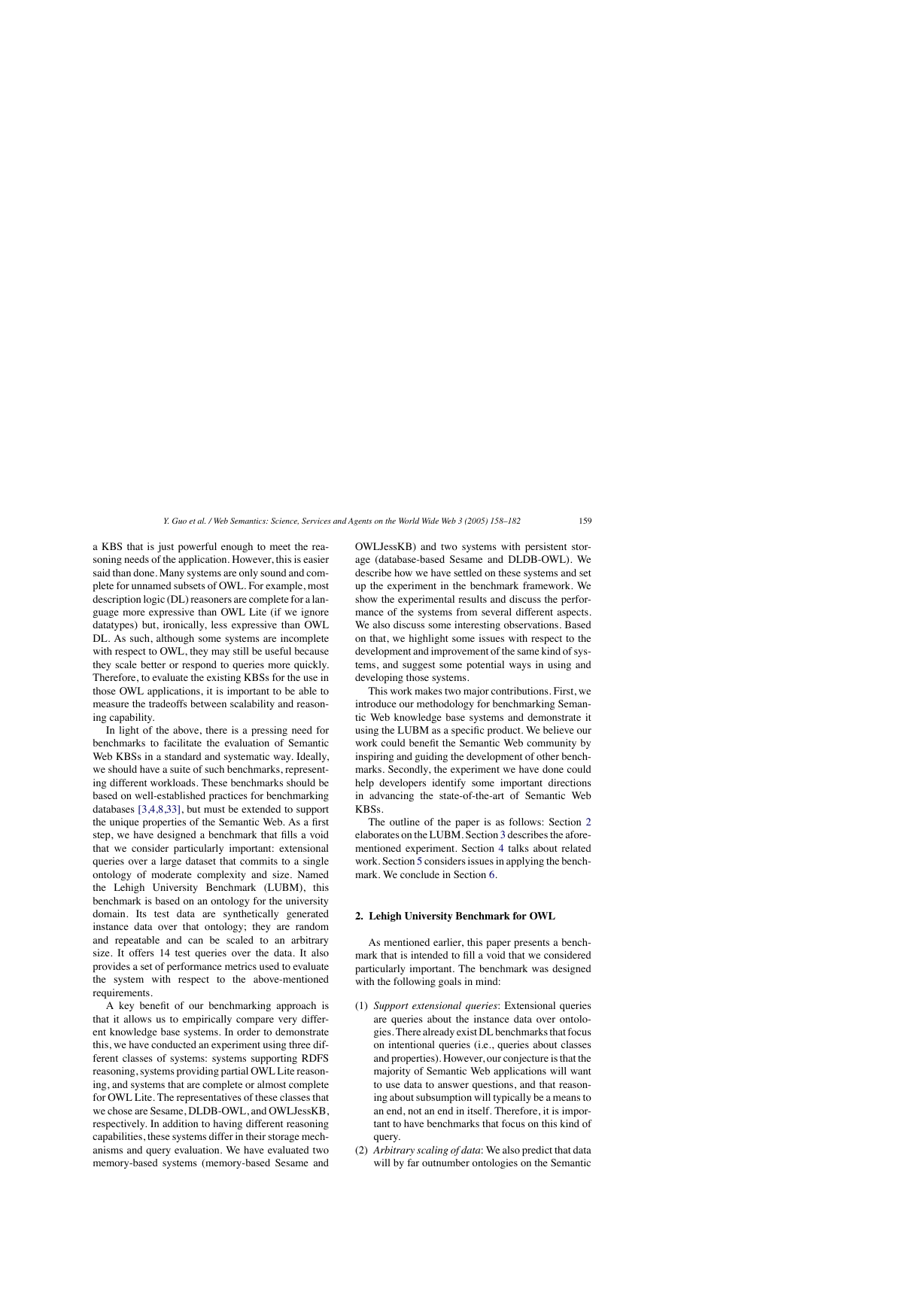
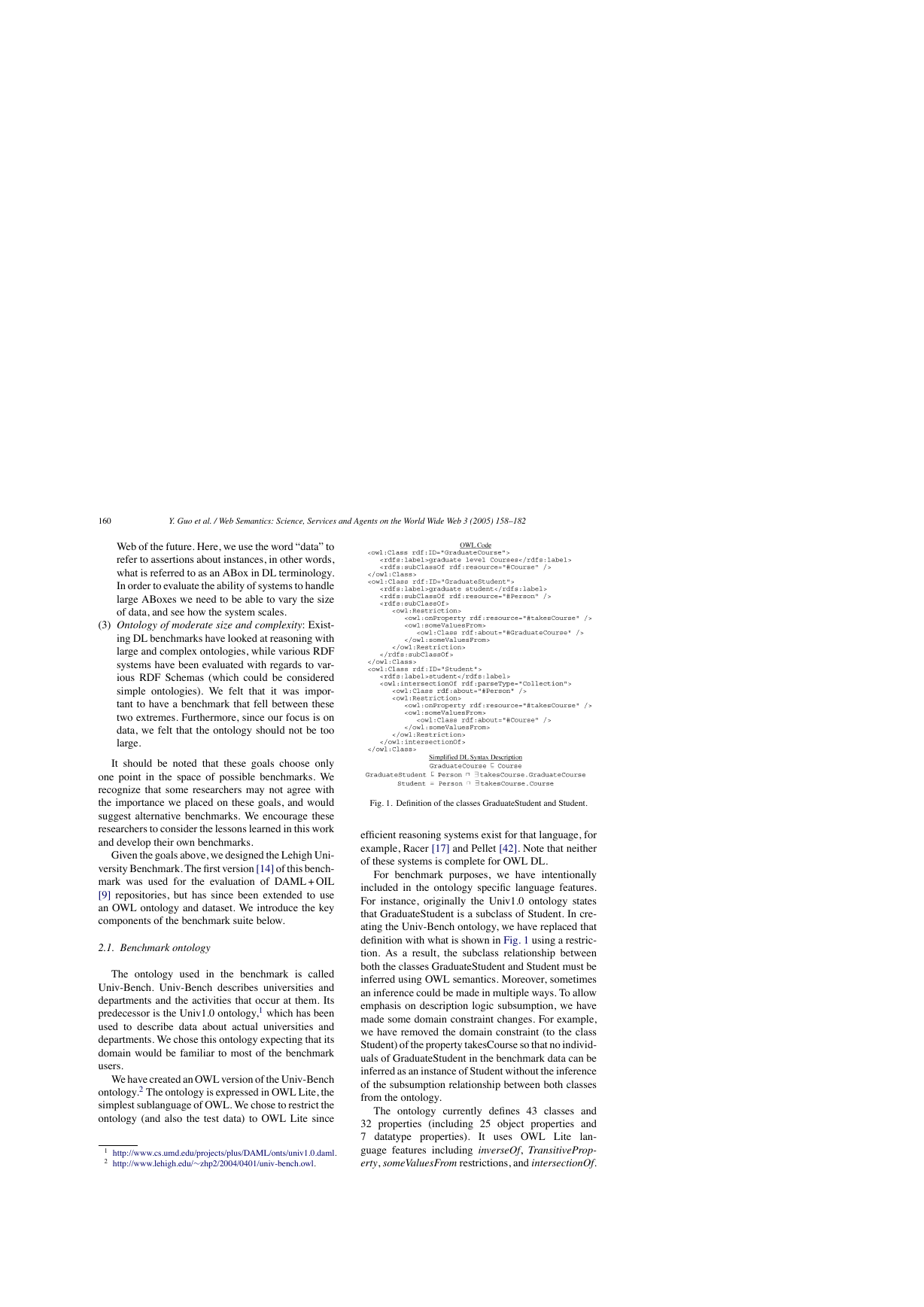

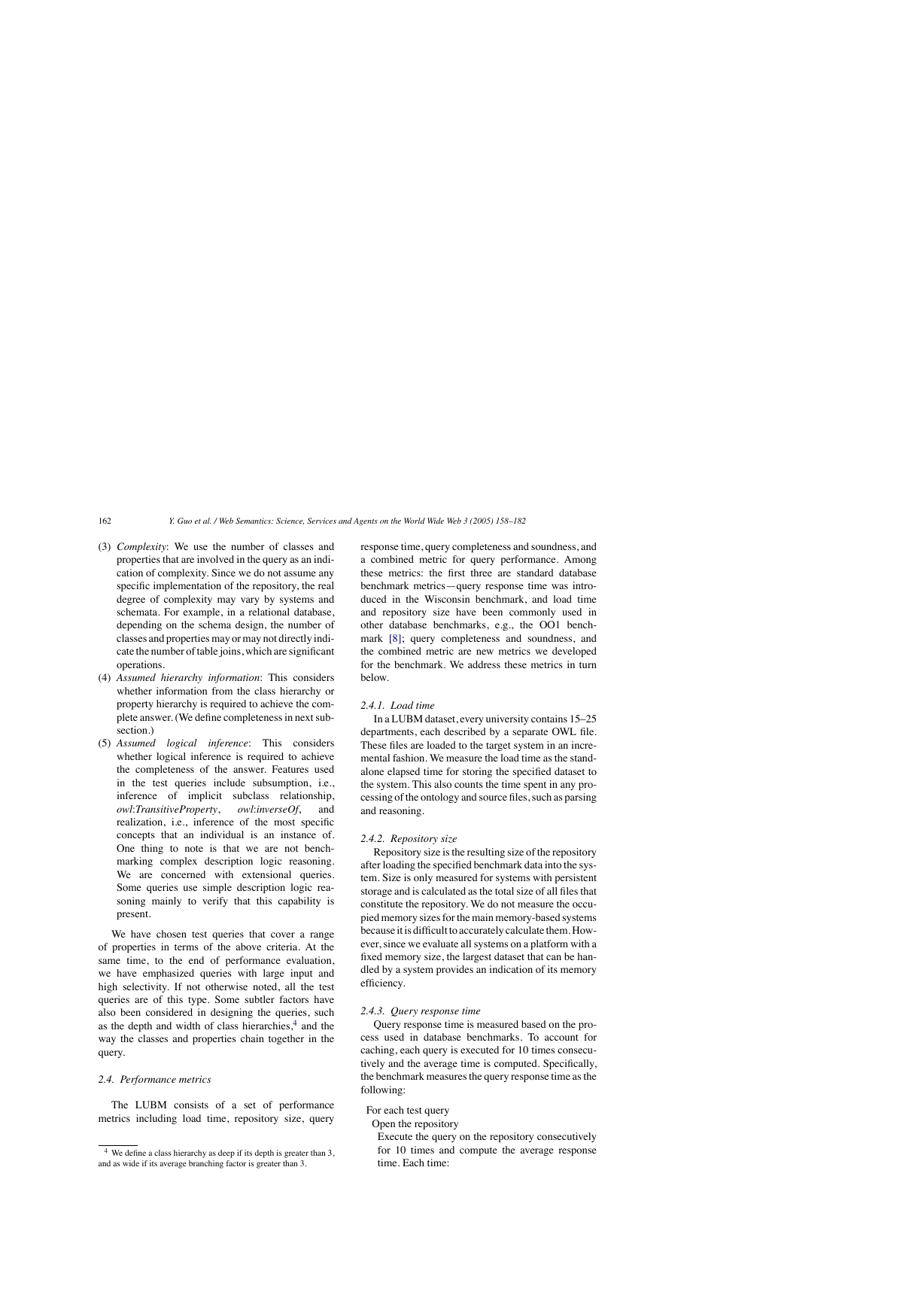
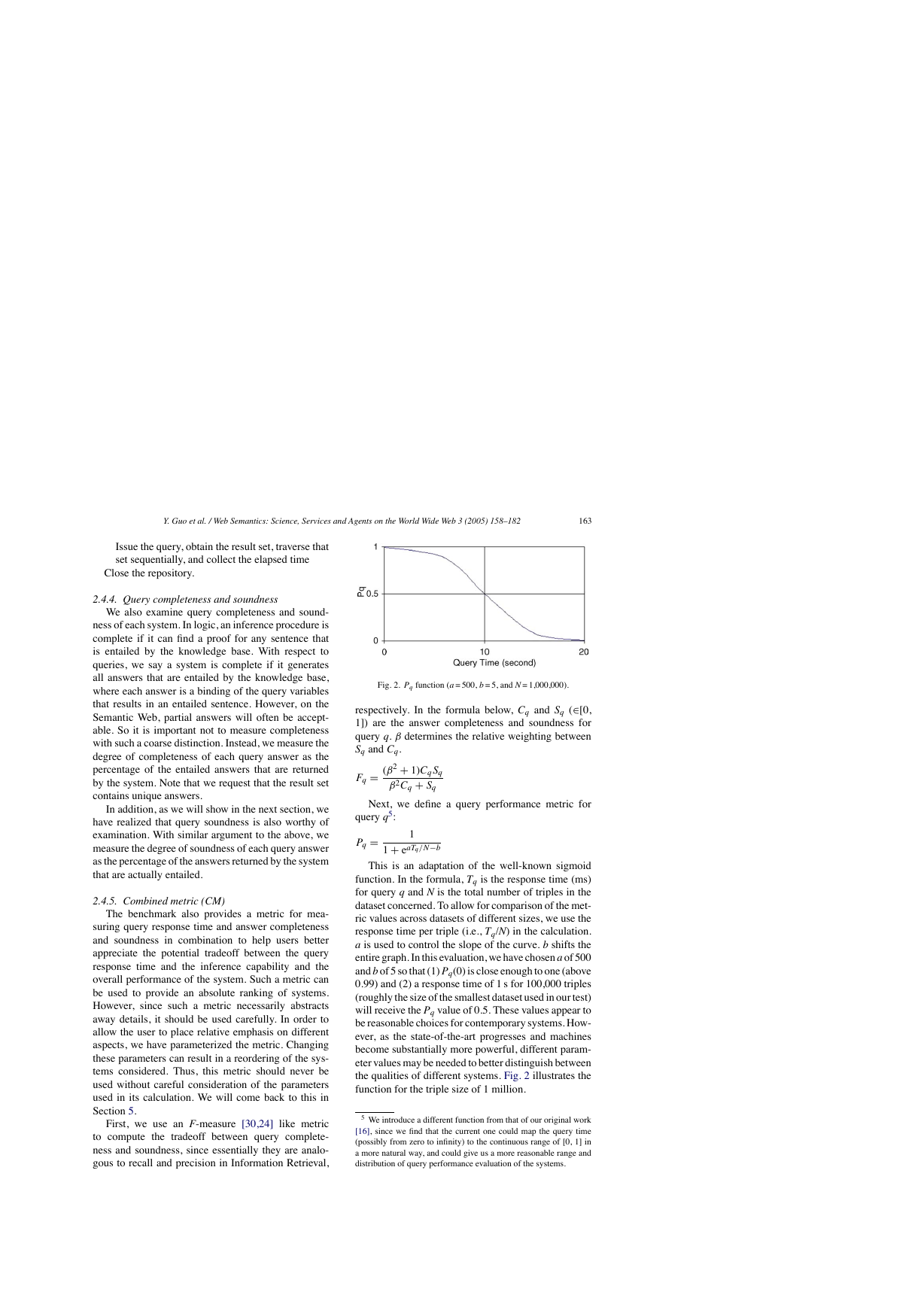
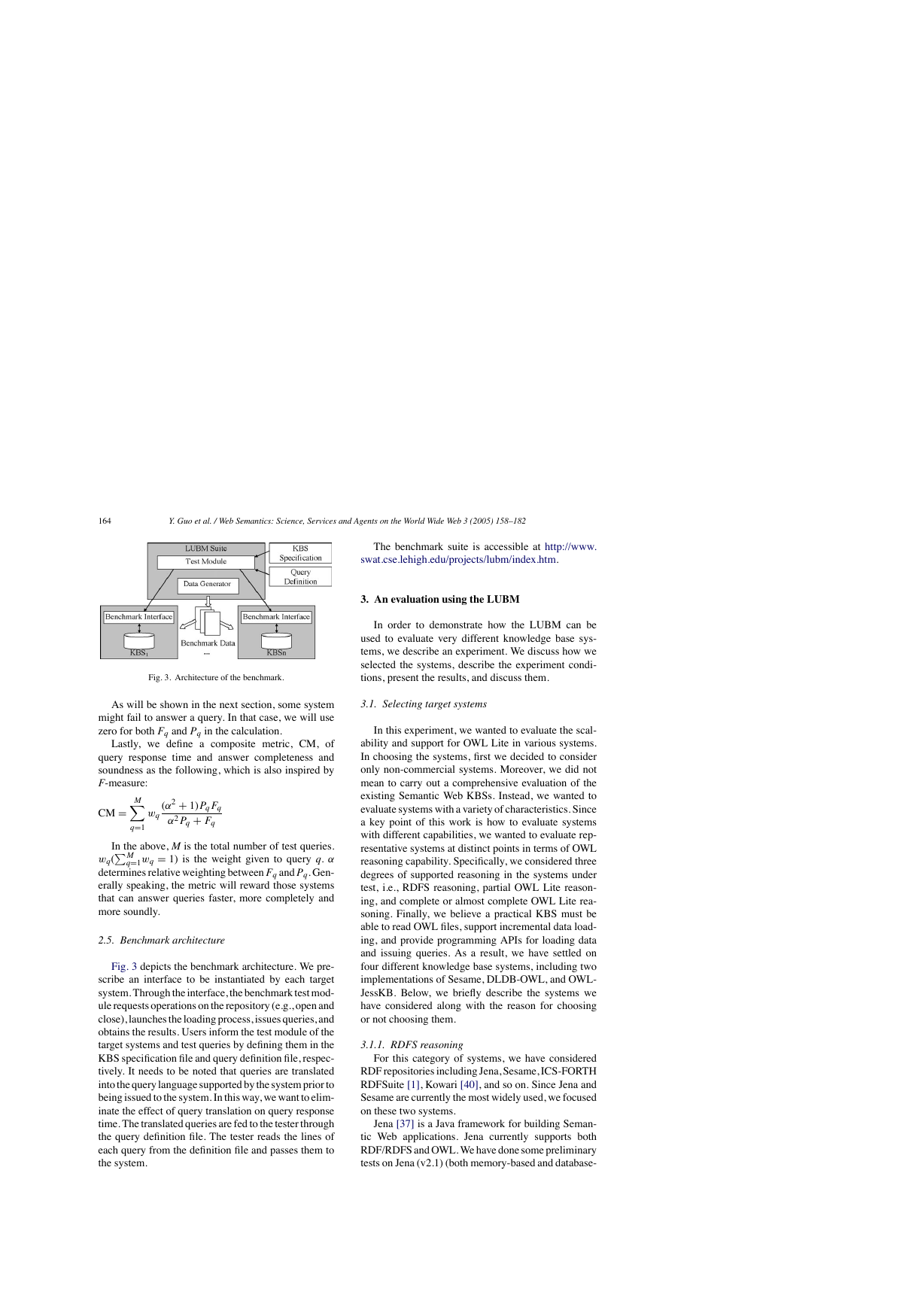
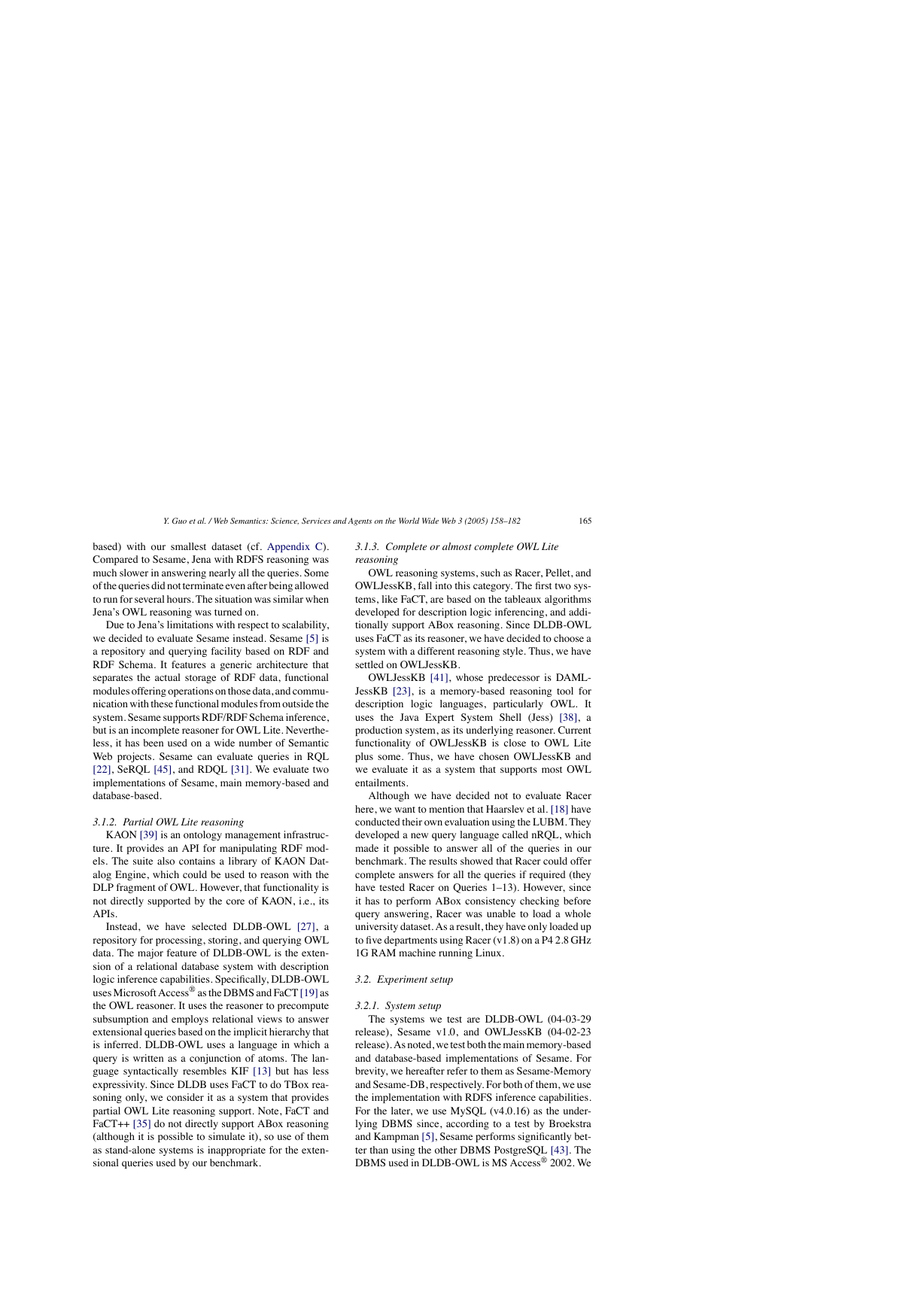








 2023年江西萍乡中考道德与法治真题及答案.doc
2023年江西萍乡中考道德与法治真题及答案.doc 2012年重庆南川中考生物真题及答案.doc
2012年重庆南川中考生物真题及答案.doc 2013年江西师范大学地理学综合及文艺理论基础考研真题.doc
2013年江西师范大学地理学综合及文艺理论基础考研真题.doc 2020年四川甘孜小升初语文真题及答案I卷.doc
2020年四川甘孜小升初语文真题及答案I卷.doc 2020年注册岩土工程师专业基础考试真题及答案.doc
2020年注册岩土工程师专业基础考试真题及答案.doc 2023-2024学年福建省厦门市九年级上学期数学月考试题及答案.doc
2023-2024学年福建省厦门市九年级上学期数学月考试题及答案.doc 2021-2022学年辽宁省沈阳市大东区九年级上学期语文期末试题及答案.doc
2021-2022学年辽宁省沈阳市大东区九年级上学期语文期末试题及答案.doc 2022-2023学年北京东城区初三第一学期物理期末试卷及答案.doc
2022-2023学年北京东城区初三第一学期物理期末试卷及答案.doc 2018上半年江西教师资格初中地理学科知识与教学能力真题及答案.doc
2018上半年江西教师资格初中地理学科知识与教学能力真题及答案.doc 2012年河北国家公务员申论考试真题及答案-省级.doc
2012年河北国家公务员申论考试真题及答案-省级.doc 2020-2021学年江苏省扬州市江都区邵樊片九年级上学期数学第一次质量检测试题及答案.doc
2020-2021学年江苏省扬州市江都区邵樊片九年级上学期数学第一次质量检测试题及答案.doc 2022下半年黑龙江教师资格证中学综合素质真题及答案.doc
2022下半年黑龙江教师资格证中学综合素质真题及答案.doc